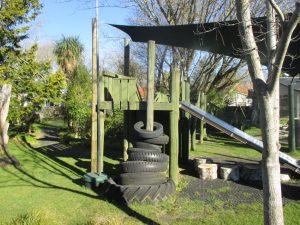
“The fort was in desperate need of recladding”.
With a long list of maintenance tasks and an even greater wish-list of potential outdoor area changes, the staff and whānau at Cambridge Kindergarten (Silver Enviroschool) recognised that this was going to be a big job!
One thing was clear – they would make sure that whatever they created, they made the most of, worked with and respected the historic trees that were in the centre.
To help focus their energies for the re-development of the outdoor area, staff spent time observing the current play patterns and assessing positives and negatives of the grounds and equipment. They noticed a number of issues with the current layout of natural and built play spaces. The fort desperately needed recladding.
The children were finding it difficult to access the potting space and propagation area kōwhai and kākā beak seedlings. Gardening was something the children loved doing with the teachers on a regular basis but were limited with the existing garden area. Three recently gifted ducklings required proper housing and space.
Vision: to create an inspiring outdoor environment for children to enjoy and develop to their full potential:
- An environment that fostered curiosity, exploration, creativity and sustainability.
- An environment that would harness nature as the third teacher enabling children to make their own discoveries about the natural world and the living eco-systems within it.
- An environment that would awaken all the senses with natural resources like water, mud, sand, plants, creatures and other textural treasures of Papatūānuku.
- An environment that provided children with wonderful opportunities to foster gross motor development, to take risks and embrace challenges.
- An environment that welcomed busyness, but also provided spaces for peace, tranquillity and thought. Ultimately an environment that allowed children to be kids, to connect with nature and direct their own learning.
A lot of questions were asked:
- How could they better utilise this space to also include a mud kitchen and tree house that would awaken the senses, curiosity, exploration and imagination of the children?
- How could water be collected to service the gardens and care for their pets?
- How could Māori Perspectives be authentically woven through their planning and design so that it became part of the teaching and learning programme?
- How could the plantings and garden spaces become healthy living ecosystems for even more bugs, bees and butterflies?
- How could they incorporate a permanent shade house that allowed children to take more ownership of raising the native seedlings?
- How could they extend the vegetable beds to grow more food (including berries, herbs and also a living tunnel)?
Exploring alternatives
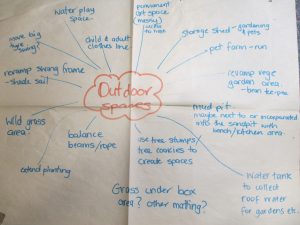
“Staff worked with the children and community to brainstorm ideas and develop a vision”.
Initially the teachers completed and compiled research individually, exploring ideas that they thought would enhance their outdoor environment.
Collaboratively, they discussed each of these before developing the ideas behind their vision.
The children were involved in some of the discussions and asked about their thoughts on aspects of the proposed changes.
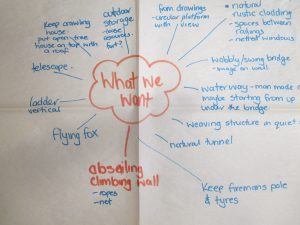
Likewise, whānau were also invited to comment on the vision and concepts.
An inspirational planning wall displayed ideas and various concept drawings and photos.
This was a wonderful learning experience for the teachers, children and the kindergarten community.
There was a buzz of excitement in the air about the potential and possibilities…where would it end?

“The inspirational planning wall helped keep everyone informed”.
Connecting and working with a passionate landscape designer (one who has a personal dedication to nature play) who understood the principles behind the vision meant that staff immediately felt supported and that these principles and their ideas were reflected in the concept drawings and design development.
Through hours of kōrero, sharing design notes, hearing recommendations, building processes, sourcing natural/ local/ free/ repurposed materials, the final plan took shape!
“This natural living landscape will be a very special place to come together to learn about the natural world through hands on experiences” – Diana Montgomerie, Teacher.
Taking action

“The chooks and ducks are housed, water collection system is in place…
In order to keep the project manageable, the development happened in stages. Led by dedicated teacher, Diana, the project involved many people to bring it to fruition, including all the teachers at Cambridge Kindergarten, the children, the kindergarten families and the support of the community.
It involved many hours of work compiling grant applications to source the funds to complete the work and purchase resources that could not be sourced for free.
Community help and working bees enabled the kindergarten to re-build the vegetable beds, paint the shade house, build a lean-to shed for the childrens’ garden tools and rebuild the swing bridge on the fort. This helped keep monetary costs down.

“… and the fort has had a make-over!”
It was important to the teaching team that the process stayed authentic and true to their vision right down to sourcing the materials for each stage with the support of their community.
Mānuka was used instead of driftwood for the ducks run/home and the living tunnel, as this was a natural resource in the area.
Likewise, Macrocarpa flitching, a natural waste product was utilised to clad the fort.
Gum and tōtara were used for the tree house, pallets were repurposed, and a stainless-steel sink sourced to create a mud kitchen (kindly crafted by a husband of one of the teachers).
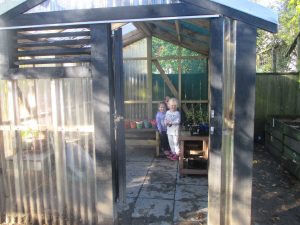
This new shade house and potting area is a great place to learn about kōwhai seedlings!
Rocks and stones were brought in locally. A parent sourced ponga to reuse to create dividers and spaces within the environment.
Native planting played an important part in sustaining the native bird life within their garden and creating tranquil open-ended space for relaxation and creative exploration.
Large, locally-sourced rocks were brought in for the garden and sandpit re-development.
A new garden was dug so that children could plant it up to encourage beneficial insects.
Reflect on change
This re-development project allowed Cambridge Kindergarten to weave the Enviroschools Guiding Principles and kaupapa into their processes and daily practices in the playscape.
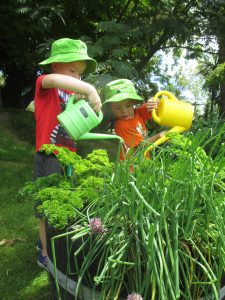
“Children learn how to care for the herbs they grow for cooking muffins, scones and soup.”
The resulting spaces are living and breathing evidence of their passion and dedication towards enabling children to get up close and personal with living ecosystems and natural cycles.
It oozes sustainability and the natural environment as the third teacher.
It empowers children to actively take a part in being kaitiaki for their natural and living environment.
“Connected to the organic edible garden is the sustainability centre. This area enables children to participate in daily rituals and sustainable practices to grow food and influence positive behaviour to the earth” – Anna Gentry, landscape designer.
Now the children, ducks and chickens at Cambridge Kindergarten can all be free range, with their own spaces (and confines).
The new approach is constantly providing opportunities for critical thinking and problem solving. It fosters new learning opportunities on a daily basis and is forever evolving.
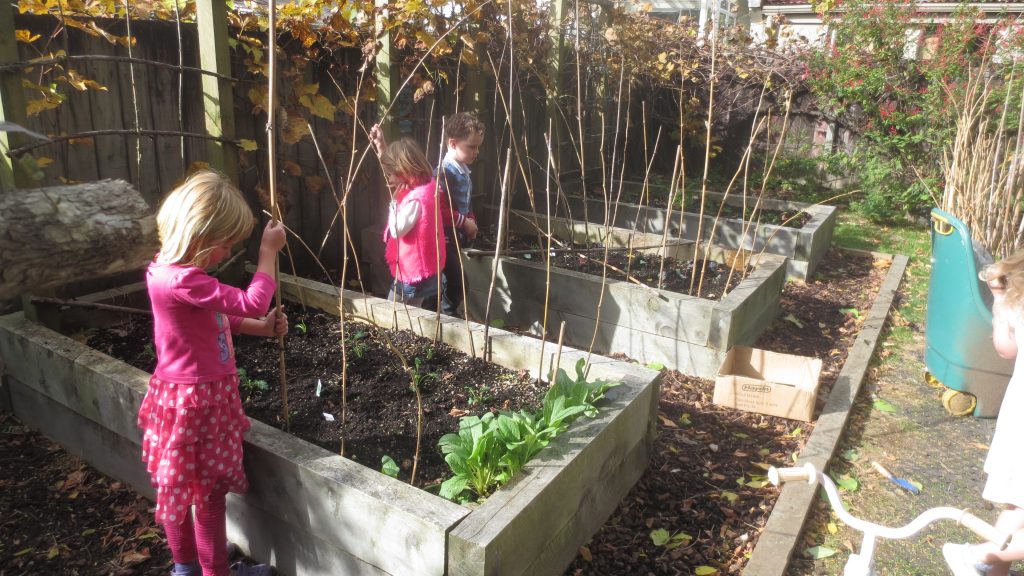
“The children observed the ducks in the vegie garden and came up with their own solution –
great problem-solving!”